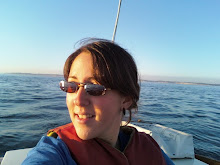Last week, on a work-related trip, I got to see inside NOAA's National Marine Mammal Labs (NMML) in Seattle with resident researcher Jim Thomason as the wonderful tour guide.
The first areas Jim showed me were the tooth lab, scat lab (which smelled delicious), and collections of otoliths (fish ears) and cephalopod (octopus and squid) beaks from the scat of northern fur seals.
From there we went to the osteological collection and looked at a juvenile gray whale confiscated from a Hood Canal resident who didn't have permits. The next room was full of orca skulls, ribs as tall as Arvydas Sabonis -- who is 7'3" -- beaked whale skulls, and other cetacean miscellany. Many of the orca skulls were from the orcas captured in Puget Sound in the 1960s and 70s. Wow, there's some orca history to never forget.
Once I got over my fascination of the shelves of orca skulls, I saw a skull from one of my favorite whales -- a male strap toothed whale! These whales are so cool; the males have these two teeth -- almost two and a half inches in width -- that grow over their rostrum in old age, limiting the amount they can open their mouths. As a result, these whales have learned to use suction to get at their food.
On the other side of the collection we looked at skulls of polar bears, walrus, and crabeater seals -- which have these amazing plankton-sifting, prehistoric-looking teeth.
 Wouldn't you love to have some teeth like these?
Wouldn't you love to have some teeth like these?All in all it was a great trip to a place I never thought I would see. If you had told a 10-year-old me that I would one day see such a collection, I'm fairly certain I would have dropped dead on the spot. Jim was a fantastic tour guide, and I hope to be able to visit again.




